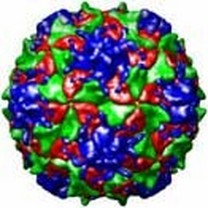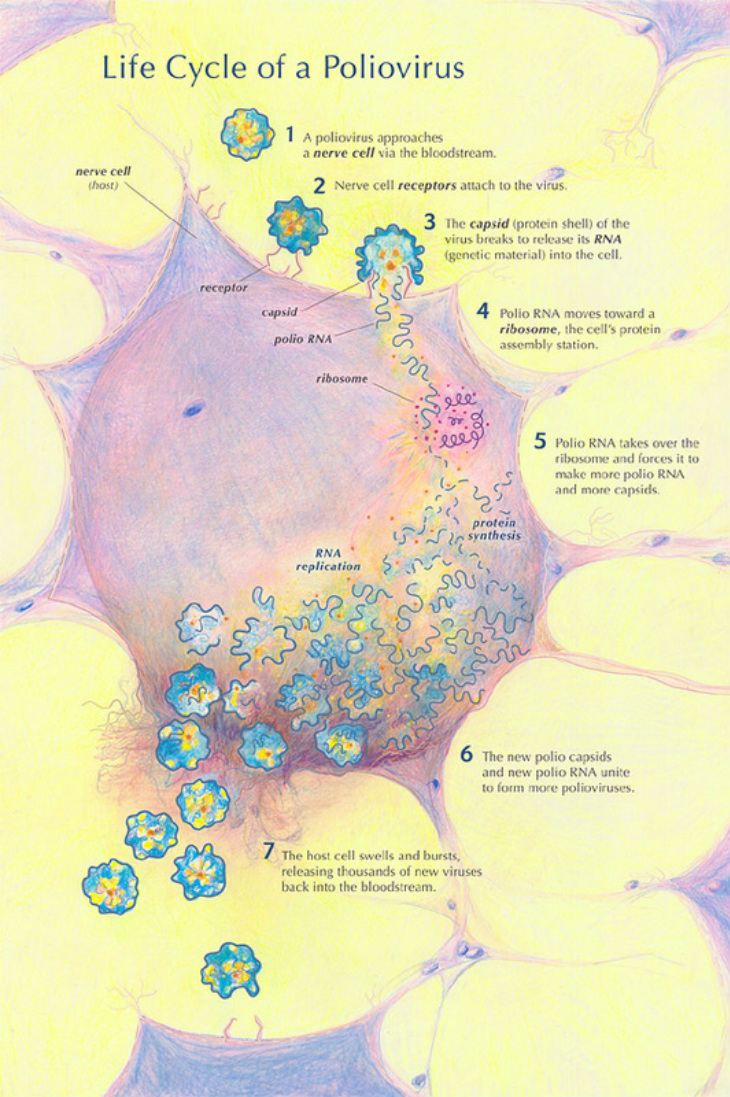The Polio Virus

1. Attachment/ Absorption: The capsid of poliovirus is composed of an icosahedral arrangement of 60 protomers, each containing polypeptides VP1, VP2, VP3, and VP4. These were all derived from cleavage of original protomer VP0. The virus binds to the host cell receptor, requiring interaction of the viral binding site with the host cell receptor. The specific binding site on poliovirus involves VP1, VP2 and VP3 which interact with host cell receptor CD155, an immunoglobulin-like molecule with 3 domains. The virus infects lymphoid and epithelial cells in the gut and neurons.2. Penetration: The viral RNA is released into the cytoplasm of a host cell through a membrane channel.
3. Uncoating: The virus undergoes changes upon attachment due to the loss of VP4. This means that it is no longer harmful to the body. However, 1 out of 200 virus particles is able to successfully transport the RNA into the cytoplasm quickly enough where it can commence synthesis of macromolecules of new virions.
4. "Shut-off" of host cell macromolecular synthesis: Host cell protein synthesis and RNA synthesis are inhibited. This process frees up more ribosomes to translate the viral genomes and to ensure that the cell will break down and die, ultimately releasing the newly assembled viral particles. Eventually, a sharp decrease in cellular macromolecular synthesis will occur.
5. Synthesis of viral components: The viral RNA codes for all the proteins needed during replication and it is infectious itself. The central key in replication of RNA viruses is the viral RNA-dependent RNA polymerase. The 53 kDa poliovirus polymers carry out viral replication in the host cell cytoplasm. Protein synthesis, protein processing, and RNA replication of the viral genome.
7. Maturation: The newly synthesized RNA is packaged inside a capsid. Viral particles are assembled through morphogenesis, and proteolytic cleavage of the capsid protein forms the final particle. A P1 polyprotein precursor is then cleaved into a protomer composed of VP0, 1, and 3, which unite together and envelop the viral RNA.
8. Release: Particles are released from the host cell through cell lysis. The free viral particles are now allowed to infect other host cells to spread across the body. Migration to the nerve tissue will result in the characteristic pathology of paralytic poliomyelitis.
Click Here for an animation.
3. Uncoating: The virus undergoes changes upon attachment due to the loss of VP4. This means that it is no longer harmful to the body. However, 1 out of 200 virus particles is able to successfully transport the RNA into the cytoplasm quickly enough where it can commence synthesis of macromolecules of new virions.
4. "Shut-off" of host cell macromolecular synthesis: Host cell protein synthesis and RNA synthesis are inhibited. This process frees up more ribosomes to translate the viral genomes and to ensure that the cell will break down and die, ultimately releasing the newly assembled viral particles. Eventually, a sharp decrease in cellular macromolecular synthesis will occur.
5. Synthesis of viral components: The viral RNA codes for all the proteins needed during replication and it is infectious itself. The central key in replication of RNA viruses is the viral RNA-dependent RNA polymerase. The 53 kDa poliovirus polymers carry out viral replication in the host cell cytoplasm. Protein synthesis, protein processing, and RNA replication of the viral genome.
7. Maturation: The newly synthesized RNA is packaged inside a capsid. Viral particles are assembled through morphogenesis, and proteolytic cleavage of the capsid protein forms the final particle. A P1 polyprotein precursor is then cleaved into a protomer composed of VP0, 1, and 3, which unite together and envelop the viral RNA.
8. Release: Particles are released from the host cell through cell lysis. The free viral particles are now allowed to infect other host cells to spread across the body. Migration to the nerve tissue will result in the characteristic pathology of paralytic poliomyelitis.
Click Here for an animation.

